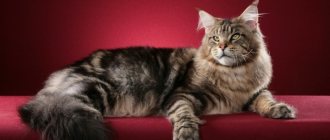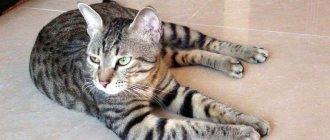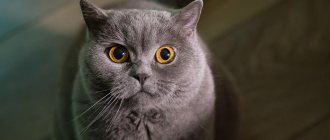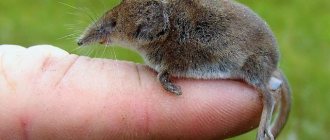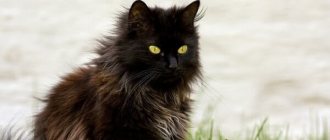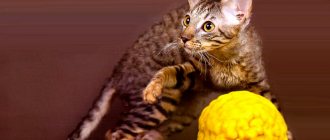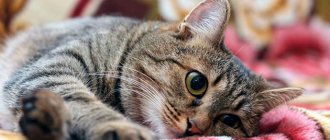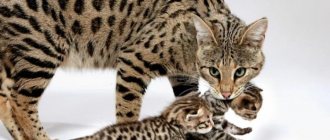Origin story
Two hairless breeds are recognized - the Don and Canadian Sphynxes.
The history of the Canadian breed began in 1966, when an ordinary cat in Canada gave birth to a hairless kitten. The baby was given the nickname Prune. He was crossed with his mother, resulting in both furry and hairless cubs. Prune continued to participate in matings with relatives. Hairless kittens were born weak, many died.
The history of the breed could have ended before it really began, but in 1975 a boy was born in the city of Waden, who was given the nickname Epidermis. Then a healthy bald girl was born. These individuals were sent to a nursery for breeding. Thus began the successful spread of the breed.
The history of Don cats is shorter. In 1986, Rostov resident Elena Kovaleva saw boys mocking a kitten. The woman drove away the hooligans and took the unfortunate animal home. The stress experienced was so strong that all the fur came out of the kitten, named Varvara. The treatment was unsuccessful.
Four years later, Varvara gave birth to hairless kittens from a short-haired cat. One of the cubs, the girl Chita, was taken for breeding by breeder Ira Nemykina. This cat became the ancestor of the Don Sphynxes. The breed was registered in 1996.
Hairless cat breeds
Hairless cats are not alike. Each has its own phenotype, its own genetics of hairlessness.
Don Sphynx
The modern Don Sphynx cat is an elegant medium-sized animal (25-30 cm) with velvety and hot skin. Donetsk residents are distinguished by the beauty of their almond-shaped eyes, but they cannot boast of the thickness of their mustaches - the Don sphinxes always have them broken off.
The first name of the breed is Russian Hairless. But it had to be abandoned because the name did not correspond to the truth. In a litter, there can be both naked kittens, lacking not only hair, but even whiskers and eyebrows, and:
- Velor Don Sphynxes - their soft fluffy fur resembles the most delicate suede. Velor Sphynx cats lose their hair as they age.
- Brushes are dressed cats and male cats that are allowed for breeding and exhibitions.
It is curious that all sphinxes have a color that is clear literally from birth. That is, not only the possible fur of animals is colored, but also the skin itself.
It might be interesting: Non-allergenic cat breeds.
Canadian Sphynx
The size of these cats is also average (about 30 cm), but the Canadians are surprisingly heavy (up to 4 kg). Canadian Sphynxes only have the appearance of hairlessness, since in fact they have hair. But it is so short that it only feels a little suede.
Canadian Sphynx cats sweat and do it with their whole body. The sweat of cats does not have a repulsive odor, but the color leaves a noticeable, chocolate color after drying. Canadians are wonderful hot water bottles. 42ºС for a kitten is a completely normal temperature, the body temperature of an adult cat is up to 39ºС.
The Canadian Sphynx has a golden character - they are sociable and quite intelligent, they easily get used to both the house and the owner.
Breed varieties
Although the Don and Canadian Sphynxes are similar in appearance, they have different genetic origins. Among “Canadians,” the bald body gene is recessive, that is, in order to give birth to hairless babies, both the female and the male must be its carriers. In Don cats, the gene is dominant, so hairless kittens are born, even if one of the parents is furry.
Don Sphynx cats come in 4 coat varieties:
- bald;
- flock - with soft fur, similar to the touch, like peach skin, disappearing with age;
- velor – with wool up to 3 mm long;
- brush – with sparse and coarse hair.
Canadian cats are never completely hairless; their body is covered with soft, feather-like fur, which is slightly longer on the face, ears, tail and limbs.
Features of care and maintenance
Sphynxes are special cats. And caring for them has a number of differences.
According to the type of skin, pets can be different:
- Brush. They are born with little fur. As they grow older, the fur disappears in some areas, while the rest are evenly covered with hair.
- Brush point. At birth, the kitten is covered with thicker hair, the muzzle and tail are completely pubescent. In an adult animal, fur remains on some parts of the head, paws and tail. The rest of the body is covered with a delicate short flock.
- Velours. At birth, a kitten has long hair on its face, paws, and tail. Later, very short hair remains in these areas, the rest of the body is naked.
- Flock. The newborn has no eyebrows or mustache. Light fur all over the body can be determined only by touch, not visually visible, the hair length is up to two millimeters. An adult cat is completely hairless; there may be some sensation of fur on the hands.
- Straight-haired. Full coat.
There are no absolutely naked “rubber” Canadian Sphynxes.
Regardless of whether there is minimal or no fur, Sphynx cats are very thermophilic. They freeze quickly and cannot tolerate drafts. Therefore, in the room where they are kept, it is necessary to maintain optimal temperature conditions (not lower than +22...+25 °C) and humidity (30-60%).
Delicate skin can easily be burned, so you should make sure that the cat is not exposed to direct sunlight for a long time or does not lie on radiators. But optimal sunbathing is encouraged - the pet will tan slightly, which can only be beneficial.
Peterbald
Keeping your Sphynx's skin clean is the most important part of grooming. These cats have sweat glands and, with insufficient hygiene, their body becomes covered with a sebaceous film. Therefore, baths two to three times a week are mandatory. For washing, you should use special shampoos for hairless cats or children's shampoos.
The Sphynx's temperature is slightly higher than other breeds, so bathing water should be at least 38 degrees Celsius. After the procedure, you need to wipe the animal, wrap it in a towel or blanket to dry completely. It is under no circumstances recommended to use a hairdryer to avoid skin burns.
Canadian Sphynx
If you don’t have the opportunity to bathe often, you can wipe the animal’s body with wet wipes.
Due to increased sweating and lack of hair, ears quickly become dirty. Dark deposits from them must be removed weekly using cotton swabs and disks moistened with special lotions or Vaseline oil.
The eyes, due to the lack of eyelashes, also require additional care. As they become dirty, you need to remove the accumulations that have accumulated there from their corners with a napkin moistened with eye lotions or chamomile decoctions.
Teeth and claws should also be monitored and maintained in good condition.
The diet of sphinxes also needs special attention. Due to the lack of fur, the pet's heat exchange and energy consumption are very high. Cats are always ready to eat anything.
Peterbald
It is rational to feed your pets with special super-premium dry formulas for hairless cats.
With a natural diet, the cat's diet should contain a sufficient amount of protein and some fiber. In this case, you should definitely give additional minerals and micro and macroelements.
You should be very careful about your baby's nutrition. Before three or four months it is better not to take him away from his mother. The transition to self-feeding must be done carefully, introducing new food into the diet in small doses. Up to six months, kittens are fed at least six times a day, three times until they are nine months old, and only then are they switched to two meals a day.
Description of the breed
Both Canadian and Russian cats have an elegant physique, a neat muzzle, large eyes, soft, elastic, hot to the touch, covered with folds skin.
Interesting! The folding of the skin of the Don Sphynx is especially pronounced; the muzzle can be so wrinkled that the cat seems angry. Although modern selection is aimed at reducing folds.
Appearance and standards
The breed standard for the Sphynx is strict; a description of the appearance of Don and Canadian cats is given in the table.
| external sign | Canadian breed | Don breed |
| head | wedge-shaped, not elongated, with rounded contours | graceful, elongated, high cheekbones, wedge-shaped, with large eyebrows |
| eyes | large, round, with a slight slant, expressive look | large, almond-shaped |
| ears | disproportionately large, wide at the base, widely spaced | large, slightly tilted forward |
| vibrissae | short | short or curved, the hairless variety has no mustache |
| neck | short, strong | long, graceful |
| torso | medium-sized, harmoniously built, voluminous breasts | strong, sinewy, with well-developed muscles, wide chest |
| limbs | the front ones are longer than the back ones, sometimes slightly curved | medium length, graceful |
| tail | medium length, in some individuals the tip is decorated with a brush, like a lion's | medium length, straight, with rounded tip |
| weight | 3–6 kg | 4–7 kg |
Colors
The Sphynx breed comes in a variety of colors. Cats are:
- solid colors - black, white, red, blue, silver, lilac, brown (chocolate and cinnamon), cream;
- tabby - patterned (spotted, striped, marbled);
- bicolors - two-color;
- tortoiseshell – multi-colored with the obligatory presence of black and red;
- color point – Siamese color;
- calico - white color with black and red spots;
- Van – white color with slight cream-blue spotting.
The color of the iris is determined by the color, the pet can be green-eyed, yellow-eyed, blue-eyed. White sphinxes come with heterochromia - different eyes.
Comparison of Sphynxes by appearance, breed standards
The Don Sphynx appeared in the city of Rostov-on-Don; the ancestor of the breed was a hairless kitten found on the street. This breed was registered in 1986.
The Peterbald or St. Petersburg Sphynx was purposefully bred in 1994. The St. Petersburg pet was obtained by crossing the Oriental and the Don Sphynx.
The Ukrainian Levkoy breed was obtained from the Scottish Fold and the Don Sphynx in 2000.
Although all these animals are similar in the absence of fur, each breed has a number of characteristics. Based on the standards, you can see the comparative differences between these breeds.
| Canadian Sphynx | Don Sphynx | Peterbald | |
| Photo | |||
| Head | Large and long, with a straight nose. Light stop on the bridge of the nose. | Smaller and less elongated | Smaller, longer, sleeker |
| Vibrissae, eyebrows | May be missing. | Either too thick or missing. | Curved or broken. |
| Neck | Middle length. | Long. | |
| Ears | Large, widely spaced, protruding beyond the skull, “bat wing” shape. | Smaller and narrower, ends rounded. | Smaller, narrower, widely spaced on the sides of the skull, continuing the triangle of the head. |
| Eyes | Large, widely spaced, lemon shape, oriental cut. Any colour. | Less, already. Often with eversion of the eyelids. Any colour. | The smallest ones. Color - blue, blue, green. |
| Body | Medium, quite muscular. Hot. | Larger, more powerful, hotter to the touch. | Medium, muscular, smaller and sleeker. Hot. |
| Weight (male), kg | 3,5-5,5. | 3,5-7. | 3-5. |
| Paws | Strong, medium, proportional. The rear ones are higher than the front ones. The latter are often curved. Webbing between the fingers. | The front ones are straight, the toes are long (monkey). Webbing between fingers | |
| Tail | Flexible and long, reminiscent of a whip. | ||
| Leather | Thick, in folds. Visually - naked, to the touch - suede, small undercoat up to two millimeters. | Elastic, pleated. In the cold season there is fluff. | Folds only on the head, thin undercoat. |
| Color | Acceptable colors are color point, blue, lilac, chocolate, particolor, cream. | ||
| Matings | Only intrabreeds. | Crossing with American Shorthair, Devon Rex, Domestic Shorthair and Domestic Sphynx is allowed. Kittens born after December 31, 2021 can only have Sphynx parents. | Crossing with the Don Sphynx, Oriental and Siamese breeds is allowed. |
| Baldness gene | Recessive. | Dominant. | |
The disadvantages are the same for all breeds:
- too much break on the bridge of the nose;
- structural defects of the skull and muzzle;
- too weak chin;
- heavy, overly round body;
- severe curvature of the front paws.
Portbald cats
Disqualification:
- defects, tail breaks;
- keeled chest;
- strabismus and other eye defects;
- aggressive behavior;
- traces of artificial hair removal.
Canadian Sphynx
Character and behavioral characteristics
The Sphynx is a sociable cat, tightly attached to its owner, requiring constant attention. Loneliness for her is a disaster.
The character of sphinxes is kindness and tenderness, turning into pestering and importunity. Contact with the owner is so important for a cat that it can even interfere with his business. The pet's attitude towards strangers is friendly and welcoming.
Representatives of the breed willingly participate in children's games and are not inclined to bite or scratch. They get along with other cats and non-aggressive dogs without problems. The hunting instinct of sphinxes is poorly developed, so there is no need to worry about the fate of parrots and hamsters.
Care and maintenance
Sphynxes are heat-loving indoor pets; you shouldn’t take them out for walks, otherwise you can’t avoid catching a cold. The cat's place in the house should be removed from heating sources and protected from drafts. If your home is cool, you should insulate your cat's body with a soft cat sweater.
Attention! Sphynxes love to lie in the sun. But prolonged sunbathing is unacceptable; a burn may remain on the delicate skin.
Hygiene rules
Bath the Sphynx cat with zoo shampoo for hairless breeds. The owner decides how often to bathe, but usually once every 1–2 months, when the body begins to emit an unpleasant odor. Hairless pets tend to sweat excessively. If you ignore bathing, you will have to clean the furniture from brown discharge left by the animal’s skin.
The hairless sphinx's eyes lack eyelashes, which is why discharge often appears on the tear ducts. They need to be removed daily with a cloth moistened with boiled water.
The ears are cleaned with cotton wool soaked in veterinary ear lotion. The claws are shortened with a nail clipper, being careful not to touch living tissue. The procedure is carried out once every 3 weeks.
Education and training
Sphinxes have high intelligence, they are understanding, obedient and obsequious. Therefore, training a litter box, the rules of behavior and hygiene is not difficult.
A one-year-old kitten can be taught to follow simple commands: “come to me,” “give me,” “sit.” Training should take place in a playful way, and positive results should be reinforced with treats and affection.
It is strictly forbidden to be rude and aggressive in raising a Sphinx. The pet is touchy and will forever remember cruel treatment.
What to feed the Sphynx
The best option for feeding the Sphynx is store-bought super premium or holistic food. It is advisable to choose a product designed for hairless cats.
If the cat eats natural food, then the diet should include:
- meat and offal;
- cereal porridge;
- eggs;
- vegetables;
- fermented milk products.
Important! Due to their fast metabolism, sphinxes are gluttonous; the daily portion of food for them is 2 times more than for ordinary cats. But overfeeding is unacceptable; it poses a great health hazard.
You can't feed the sphinx:
- fatty meat;
- fried foods;
- salinities;
- smoked meats;
- sweets;
- spices;
- bakery products;
- waste from the master's table.
Care and nutrition
Also, the care of such animals includes washing the ears and eyes. Since these animals are quite large, they require attention. A lot of dirt gets into the ears, which the cat cannot cope with on his own. And due to the fact that hairless cats do not have eyebrows or other fur that protect their eyes from dust and dirt, a human hand is also necessary here.
Since sphinxes are not warmed by fur, they must eat more often and balanced food, because heat exchange is generated twice as fast as in cats with fur. Therefore, when purchasing quality food, make sure that it contains the required dose of calories.
In addition to this, hairless cats must be given the following from childhood:
- beet;
- cauliflower;
- carrot;
- cottage cheese;
- egg yolk;
- zucchini;
- kefir;
- boiled fish and meat.
All this can be added to liquid feed.
Sphynx kittens
You should buy a kitten from a reputable cattery. The seller must draw up a sales contract, provide the buyer with a veterinary passport indicating the vaccinations performed and a metric on the basis of which a pedigree can be requested.
Breeding
Crossing the Don and Canadian Sphynxes is prohibited. You cannot breed two completely hairless individuals, even of the same breed, as the cubs will not be viable.
Males mature at 8 months. The first estrus in females is observed at 6–7 months and proceeds rapidly. The Sphynx girl meows at the top of her lungs and behaves nervously and fussily. But you can’t knit at an early age, it will negatively affect the offspring and the health of the parents. Both the male and the female must be one and a half years old.
Vaccinated and healthy animals checked by a veterinarian are bred. Their claws are trimmed to prevent accidental injuries. The cat is taken to visit a gentleman and left for a couple of days.
Pregnancy lasts 63–65 days. Childbirth usually occurs without complications and human assistance is not needed. There can be up to 12 cubs in a litter.
Price
The cost of a representative of the breed is determined by pedigree and exhibition category. A pet-level pet (companion) can be bought for at least 5 thousand rubles. And the cost of breed kittens (for breeding) and show-level kittens reaches 100 thousand rubles.
How to choose the right one
When choosing a kitten, pay attention to the following signs of a healthy animal:
- affectionate, playful, active, friendly behavior (if the kitten is angry and fearful, then he is being mistreated or has mental problems);
- moderately well-fed body;
- clear teardrops of the eyes;
- ears and anus without discharge;
- skin without signs of dermatitis.
How to care in the first months
A kitten is purchased when it is 3 months old; at this age it already knows how to use a litter box and is vaccinated. The breeder is obliged to tell the buyer how to care for the pet. It is worth getting a phone number from the breeder so you can call if you have questions.
You should ask the breeder what food the kitten was fed in the nursery. The transition to another diet should be smooth so that the pet’s digestion is not disrupted.
The purchased kitten is taught to bathe and other hygienic procedures. Up to six months they feed 6 times a day, up to a year - 3 times, then - 2 times.
Cost of kittens
When purchasing a Sphynx kitten, you must first decide on the purpose of the purchase.
If the owner is interested in the pet as a pet, then the kitten can be bought quite cheaply - from ten to thirty thousand. The cheapest value is the Ukrainian Levkoy, the most expensive are the Canadian Sphynxes.
But a pedigree cat of this breed from titled parents and from a renowned nursery can be purchased for several thousand dollars.
New, experimental breeds of hairless cats are also still very expensive. The price for a Bambino or Cojona kitten starts from a thousand dollars and they can only be found in nurseries in the United States of America and Canada.
TOP 10 facts about sphinxes
Here is a brief summary of everything interesting about sphinxes:
- Hairless cats existed in ancient times. The Egyptians kept them in temples, and the Aztecs considered them healing animals.
- The ancient cats became extinct. And the living sphinxes are an artificial breed obtained as a result of a gene mutation.
- The average lifespan of cats is 14 years. But there are long-livers, reaching up to 17–19 years.
- The body temperature of the sphinx reaches 39 °C.
- Representatives of the breed love swimming in warm water.
- Sphynx cats are not hypoallergenic, despite their lack of fur. Their saliva contains the same amount of allergen protein as other breeds.
- Hairless cats love to sleep in the master's bed under the blanket. After all, this is the warmest place.
- A newborn kitten opens its eyes after 3-4 days.
- Sphynx cats have sensitive skin, so they love to be petted and caressed.
- Due to their increased metabolism, cats defecate 3 times more often than other breeds, and the smell of their feces is intense. Therefore, you have to clean the tray often.

